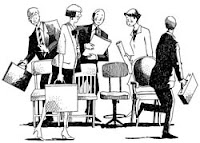It might seem strange that I have to write something with this title, but I was at a meeting yesterday where a board member proudly explained:
“We don’t have a fundraising committee – we don’t want to relegate that function to a committee. Fundraising is every board member’s job.”
Well yes – but…
It’s the old saw…If everyone takes it home, no-one takes it home. Who thinks about it in the shower?

It is certainly important for every board member to participate in fundraising. To search honestly and deeply for how, in their own lives, they can bring their nonprofit board service to the fore. To be a 360° advocate, raising friends and uncovering hidden fans at every turn.
But there’s something special about a group that is specifically committed to steering the board’s willingness into action, making sure that each piece is more than the sum of its parts. Whose job is not just to do, but to shepherd. And which has the responsibility for driving the big picture forward.
There’s a theory floating around that board fundraising committees – nay, all “standing” board committees – are dinosaurs. That instead of a board fundraising committee per se, what is needed is ad hoc activity-related task forces, like an event steering committee, annual appeal working group, capital campaign committee, etc.
We at Cause Effective have a big problem with this theory. And that is – that this reduces fundraising to isolated strategies, and directs the agency’s attention towards the what, not the who. In other words, the primary driver of board fundraising deliberations becomes
What activities should we do for fundraising? instead of
Who might care about us and how can we reach them successfully?
The board fundraising committee should be looking at the totality of prospects (friends, fans, volunteers, donors) within the universe in which the organization and its advocates move. That universe, and its interests, connections and possibilities, determines the activities the board should take to raise funds and friends. It’s the old cart and horse.
You may end up at the same place – a series of cultivation activities punctured by a couple of direct asks – but you’re starting from an understanding of the why and the who – which will ultimately result in deeper connections to an ever-expanding donor pool.
This…is what the board fundraising committee should have on its mind, and be mulling over in the shower. The stability, the sustainability, and the grow-ability, of the organization’s circle of supporters.









